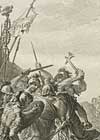Introduction
Adam Weishaupt considered his Order of the Illuminati, often seen as the mother of all secret societies, as the greatest thing ever invented by human reason. Yet the nature and significance of such organizations are subject to much debate. Statesmen from Metternich to Disraeli and revolutionaries from Buonarroti to Bakunin were convinced of their importance and effectiveness. The assassination in Sarajevo that unleashed the First World War was attributed to the Black Hand; and the hand of the Elders of Zion has been and is seen everywhere. It is true that today's bookshops resolutely shelve the topic with UFOs, wicca, and the tarot, but there is also many a website warning against 'the secret societies' that threaten to march towards world hegemony unopposed, possibly under the aegis of the United Nations. And two of our more well-known contemporaries, Osama bin Laden and Dan Brown, have focused a great deal of media attention on such hidden things.
Historically speaking, the term 'secret society' (in the alliterative form also known from 'société secrète' and 'geheime Gesellschaft') is closely connected to the turbulent final quarter of the eighteenth century and the conspiracy theories that became ever more venomous and popular in the wake of the French Revolution. The alleged power and methods of Freemasons and Jesuits provided the ground for stereotypes developed and disseminated by friends and foes alike. Ten years into the Restoration period, 'the secret societies' was an expression with a strong political connotation that was understood throughout Europe. For the rest of the century, colonial officers and early anthropologists exported it to all the corners of the world, with unexpected and sometimes unpleasant consequences for those it was supposed to include. Little by little, however, the phenomenon came to be seen as incompatible with modernity; organizations that had once been considered 'secret societies' began expressly to deny that they were.
More often than not, new groups now emphasize 'clandestinity', the fact that a hostile environment forces them underground - even if its hostility is not the main reason for their secretiveness. Clearly, this position is morally more attractive than that of a willful keeper of secrets with unspoken motives to hide things from his fellow men. And to the modern ear, a 'group of covertly operating resistance fighters' sounds much more rational than a 'secret society'. Nonetheless, there are quite a few forms of continuity between the old and the new, if only because certain ways of organizing are simply congenial to both. Is modern style compartmentalization - the division into units that are not aware of the existence or composition of the others - really only a defense against the police? Does the hierarchical structure merely exist to further effectiveness? Are there really no initiation rites? Is it sheer accident that these and other characteristics are to be found in both the old and the new organizations? Such questions have no obvious answers, as does that other question of why secret services so often resemble their prey.
Secret societies leave numerous traces, even if they do not exist: after all, they arouse boundless curiosity that will sooner or later be reflected in archives and libraries. The International Institute of Social History, too, preserves many documents on interesting, important, curious, and putative secret societies and clandestine organizations from far and wide. Twelve illustrations and as many historical texts give a taste of those riches. In addition, readers will find a dozen titles from world literature that have helped spread the notion of 'secret society', as well as a dozen scholarly studies that are both reliable and a pleasure to read. Written and compiled by Jaap KloostermanChapters:
• Freemasons
• Jesuits
• Illuminati
• Carbonari
• Burschenschaften
• Grand Firmament
• France
• Germany
• Russia
• United States
• Asia
• Precursors
• Artist's Impressions
• Literature

